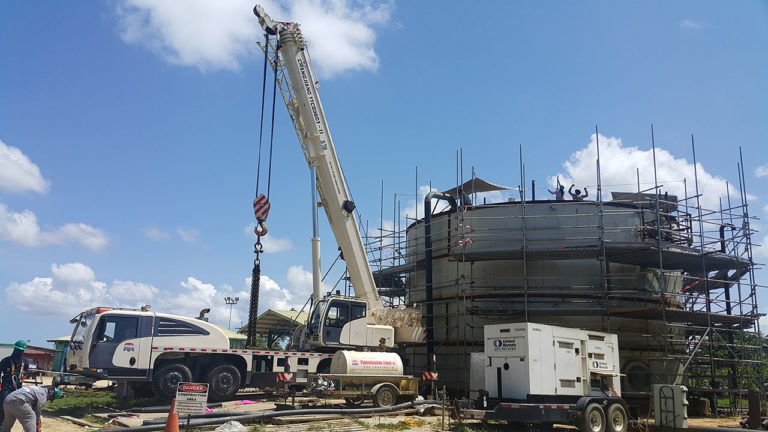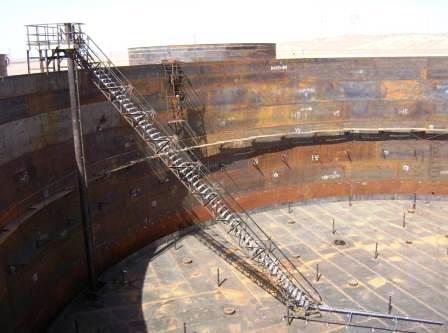Exploring API 650 Welding Inspection and Its Role in Weld Reliability
Understanding the Importance of Welding Examination in Top Quality Guarantee Processes
Welding assessment is an essential element of quality control in building and construction and manufacturing. It assures that welds abide by well established requirements, which is important for structural honesty. Different evaluation techniques, from aesthetic to ultrasonic testing, help recognize problems early. This proactive strategy not only avoids pricey repair services but additionally improves safety. Recognizing the subtleties of welding inspection can disclose its wider implications for sector compliance and online reputation. API 650 Welding Inspection. What exists below the surface area of these techniques?
The Role of Welding Examination in Quality Control
While welding is a vital process in numerous sectors, its high quality and integrity pivot considerably on efficient assessment practices. Welding assessment acts as a secure, guaranteeing that welds fulfill recognized criteria and specifications. This procedure not just identifies flaws yet also examines the total handiwork, thus adding to the safety and durability of bonded frameworks. Inspections are integral to quality control, as they aid preserve and protect against pricey failures compliance with industry policies. By utilizing knowledgeable assessors, companies can enhance their operational efficiency and support their track records. In addition, the understandings got from inspections can notify continual improvement, resulting in much better methods and training for welders. Inevitably, welding inspection serves as an important link in the quality control chain, guaranteeing that every joint is capable and dependable of enduring the rigors of its intended application. This diligence is essential for the integrity of facilities and the safety of end users.
Sorts Of Welding Inspections
Welding evaluations encompass a series of approaches created to review the quality and stability of welds. These examinations are vital in ensuring compliance with market standards and specifications. Usual sorts of welding evaluations consist of visual examination, which enables prompt identification of surface area irregularities; ultrasonic screening, which uses high-frequency audio waves to identify internal defects; and radiographic screening, utilizing X-rays or gamma rays to disclose weld stability beneath the surface area (API 650 Welding Inspection). Additionally, magnetic fragment testing is made use of to identify surface area and near-surface interruptions in ferromagnetic materials, while color penetrant testing uses a method for exposing surface-breaking defects. Each kind of evaluation offers a particular objective, adding to the total quality control process. By using a combination of these methods, inspectors can offer an extensive analysis of welding quality, eventually ensuring the security and dependability of bonded structures
Typical Flaws Detected in Welding
A range of usual issues can occur during the welding procedure, influencing the integrity and performance of welded frameworks. These issues include porosity, which involves entraped gas pockets within the weld, compromising its toughness. Splits may also create due to quick cooling or improper joint style, causing possible failing under stress and anxiety. Incomplete fusion occurs when there wants melting of the base steel, leading to weak bonds. One more flaw, damaging, entails the elimination of base steel along the weld side, developing a substantial architectural weak point. In addition, too much spatter can impact the appearance and require additional cleaning or repair. Misalignment can lead to uneven weld grains, endangering the total high quality. Determining these problems early through correct examination methods is important to ensure the dependability and safety of bonded elements, eventually safeguarding the efficiency of the whole structure.

Advantages of Routine Welding Inspections
Routine evaluations play a significant role in keeping the quality and safety of welded structures, especially because of the usual defects formerly laid out. These evaluations offer an opportunity to recognize and remedy concerns before they intensify right into major troubles, ensuring structural honesty. By spotting imperfections early, organizations can reduce repair service costs and avoid prospective task hold-ups.
Additionally, routine welding assessments boost compliance with industry requirements and guidelines, cultivating count on among stakeholders. This adherence not just shields the firm's reputation however likewise adds to boosted safety and security for personnel and the public.
Regular inspections help with much better training and skill development for welders, as comments from evaluations can lead improvements. Ultimately, the benefits of regular welding inspections expand beyond instant top quality guarantee, advertising long-lasting operational efficiency and integrity in bonded structures.
Finest Practices for Effective Welding Examination
Implementing ideal methods in welding evaluation is essential for assuring the greatest criteria of high quality and safety. Initially, examiners must be appropriately educated and certified, having a comprehensive understanding of welding strategies and materials. Making use of advanced examination innovations, such as ultrasonic screening and radiography, enhances the discovery of defects that might not show up to the nude eye. Establishing a clear assessment plan, outlining the criteria and regularity of evaluations, guarantees uniformity and thoroughness.

Documenting all searchings for thoroughly is important for traceability and responsibility. Regular calibration of examination equipment guarantees precision, while maintaining a orderly and clean work area Look At This lowers the danger of contamination. Furthermore, promoting open communication amongst group participants helps with the sharing of understandings and advertises a society of top quality. By sticking to these best practices, organizations can significantly enhance their welding quality control navigate here procedures, inevitably bring about safer and more reputable items.

Often Asked Concerns
What Qualifications Are Required for a Welding Assessor?
A welding examiner usually requires accreditation from acknowledged organizations, such as the American Welding Culture (AWS) or the International Institute of Welding (IIW), together with appropriate experience and knowledge in welding procedures and high quality standards.
Just How Commonly Should Welding Inspections Be Carried Out?
Welding evaluations should be done frequently, generally at numerous project phases, including prior to, during, and after welding procedures - API 650 Welding Inspection. The frequency commonly depends on job specifications, governing requirements, and the intricacy of the welds involved
What Are the Expenses Connected With Welding Assessments?
The costs related to welding evaluations differ widely, typically varying from a few hundred to numerous thousand bucks, relying on variables like inspection kind, project dimension, and area, affecting total job spending plans and timelines.
Can Welding Inspections Be Conducted Remotely?
Yes, welding examinations can be conducted from another location making use of innovative technologies such as drones, cameras, and ultrasonic testing. These approaches permit inspectors to assess right here weld integrity without being literally present, enhancing performance and safety in different environments.
Exactly How Do Examination Outcomes Impact Project Timelines?
Inspection results can substantially affect task timelines by determining problems early, causing required rework or modifications. Delays might happen if assessments disclose problems requiring resolution, ultimately influencing total project conclusion and budget plan adherence.
Welding evaluations encompass a range of methods designed to evaluate the top quality and integrity of welds. Typical kinds of welding examinations consist of aesthetic inspection, which allows for immediate identification of surface area irregularities; ultrasonic screening, which makes use of high-frequency audio waves to spot internal problems; and radiographic screening, utilizing X-rays or gamma rays to expose weld honesty underneath the surface. Regular inspections promote much better training and skill growth for welders, as feedback from evaluations can direct renovations. Implementing ideal methods in welding examination is essential for ensuring the highest criteria of quality and safety and security. Welding assessments ought to be carried out consistently, typically at different project phases, including prior to, throughout, and after welding procedures.